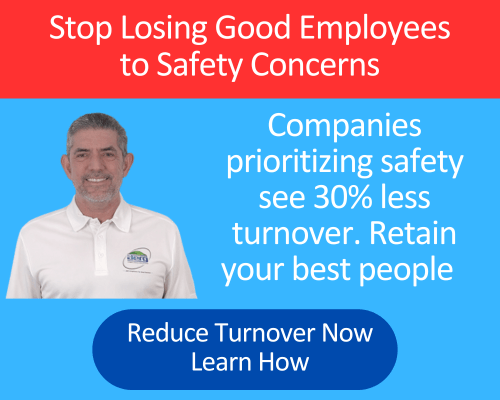Understanding the Hidden Costs of Manufacturing Employee Turnover
The Direct Financial Impact of Safety-Related Turnover
Safety-related turnover creates immediate financial consequences that directly affect your bottom line. Recruitment costs alone can be substantial, including job posting fees, recruiter expenses, background checks, and interview time. When employees leave due to safety concerns or workplace injuries, these costs multiply as you may need to fill positions more frequently than competitors with stronger safety programs.
Training new employees requires significant investment in both time and resources. Manufacturing environments demand specialized knowledge of equipment operation, safety protocols, and quality standards. The learning curve for new hires can extend several months, during which productivity remains below optimal levels. Additionally, experienced workers must dedicate time to mentoring newcomers, reducing their own output and efficiency.
Lost productivity during transition periods can be particularly costly in manufacturing settings where production schedules are critical. When safety issues drive turnover, remaining employees may work overtime to maintain output, resulting in increased labor costs and potential burnout. This creates a dangerous cycle where poor safety conditions lead to turnover, which increases stress on remaining workers and potentially compromises safety further.
| Direct Turnover Costs | Manufacturing Impact |
|---|---|
| Recruitment expenses | $3,000-$15,000 per position |
| Training investment | 3-6 months reduced productivity = $thousands in losses |
| Lost productivity | 20-50% efficiency reduction |
Indirect Costs That Compound Over Time
Beyond immediate expenses, safety-related turnover creates indirect costs that accumulate and compound over time. Institutional knowledge walks out the door with departing employees, taking years of experience and process improvements with them. This knowledge transfer gap can lead to repeated mistakes, quality issues, and inefficient problem-solving approaches that impact long-term competitiveness.
Morale among remaining employees often suffers when colleagues leave due to safety concerns. Workers may question management’s commitment to their well-being, leading to decreased engagement and productivity. This erosion of trust can create a negative workplace culture that makes it increasingly difficult to attract and retain quality talent.
Customer relationships may also suffer when experienced employees leave. Manufacturing often involves long-term partnerships where personal relationships and technical expertise matter significantly. When key personnel depart due to safety issues, maintaining these critical business relationships becomes more challenging, potentially affecting revenue and growth opportunities.
The reputation impact extends beyond current operations. In today’s connected world, former employees can share their experiences through online reviews and industry networks. Poor safety conditions that drive turnover can damage your company’s reputation, making it harder to attract top talent and potentially affecting customer confidence in your operations.
Calculating Your True Turnover Costs
Developing an accurate turnover cost calculator requires examining multiple cost categories specific to manufacturing environments. Start by tracking direct costs including recruitment, hiring, and initial training expenses. Document the time investment required from supervisors, HR personnel, and experienced workers during the onboarding process.
Measure productivity losses by comparing output levels before, during, and after employee transitions. Consider factors such as learning curves, error rates, and the time required for new employees to reach full productivity. In manufacturing settings, these productivity impacts can be particularly significant due to the technical nature of many positions.
Include overtime costs paid to existing employees who cover additional responsibilities during transition periods. Factor in temporary staffing expenses if you use contract workers to maintain production levels. Don’t forget to account for potential quality issues or customer complaints that may arise during periods of reduced experience levels.
Administrative costs often get overlooked but can be substantial. Include time spent on exit interviews, paperwork processing, equipment reassignment, and security updates. Consider the impact on team dynamics and the time supervisors spend managing increased workloads and maintaining morale during transition periods.
| Cost Category | Calculation Method | Manufacturing Considerations |
|---|---|---|
| Direct costs | Recruitment + training + admin | Include safety certification costs |
| Productivity loss | Output reduction × time period | Factor in equipment-specific learning |
| Overtime expenses | Extra hours × premium rates | Consider production schedule impacts |
The Safety Connection: Why Employees Really Leave
Poor safety conditions create a primary driver of voluntary turnover in manufacturing environments. Workers who feel unsafe or witness preventable injuries often seek employment elsewhere, even if it means accepting lower wages. This safety-driven turnover is particularly costly because it often involves your most safety-conscious and experienced employees.
OSHA compliance training deficiencies contribute significantly to turnover rates. When employees lack confidence in safety procedures or feel inadequately prepared for workplace hazards, they may choose to leave rather than risk injury. Comprehensive EHS consulting services can address these gaps, creating a safer environment that encourages retention.
Environmental health and safety programs that exceed minimum requirements demonstrate genuine commitment to worker well-being. Employees notice when companies invest in advanced safety measures, proper equipment, and ongoing training. This investment in safety creates loyalty and reduces the likelihood that workers will seek opportunities elsewhere.
Communication plays a crucial role in safety-related retention. When management fails to address safety concerns promptly or dismisses employee feedback about hazards, trust erodes quickly. Establishing clear channels for safety communication and demonstrating responsiveness to concerns can significantly improve retention rates while enhancing overall workplace safety.
Industry Benchmarks and Comparison Data
Manufacturing turnover rates vary significantly across subsectors, but safety-related departures consistently represent a substantial portion of voluntary turnover. Companies with strong safety programs typically experience notably lower turnover rates compared to industry averages, translating to significant cost savings over time.
Best-in-class manufacturers often invest substantially more in safety programs and EHS consulting services than their competitors, but this investment pays dividends through reduced turnover costs. The return on investment for comprehensive safety programs becomes clear when calculating the full cost of safety-related turnover.
Geographic factors also influence turnover costs and patterns. In competitive markets like Austin, Texas, where manufacturing talent is in high demand, safety-related turnover can be particularly expensive. Companies that establish reputations for excellent safety performance gain competitive advantages in talent acquisition and retention.
Seasonal patterns in manufacturing often correlate with turnover spikes, particularly when safety training or equipment maintenance falls behind during busy periods. Understanding these patterns helps manufacturers proactively address safety concerns before they drive valuable employees to seek opportunities elsewhere.
| Industry Comparison | Annual Turnover Rate | Safety Program Investment |
|---|---|---|
| Manufacturing average | 20-35% annually | Minimal compliance focus |
| Safety leaders | 10-15% annually | Comprehensive EHS programs |
| Best-in-class | Under 10% annually | Proactive safety culture |
Technology Solutions for Tracking Turnover Costs
Modern manufacturing operations can leverage technology to accurately track and analyze turnover costs, particularly those related to safety issues. Digital platforms can automate cost calculations, track patterns, and identify early warning signs of potential departures due to safety concerns.
Integrated OSHA General Industry 1910standards tracking systems help identify correlations between compliance gaps and turnover rates. When safety incidents or near-misses precede employee departures, these patterns become visible through proper data analysis, enabling proactive intervention strategies.
Employee feedback systems can capture safety-related concerns before they lead to turnover. Anonymous reporting tools and regular safety surveys provide early indicators of potential retention issues, allowing management to address problems before losing valuable employees. And there’s no better tool for this than creating and supporting a safety committee staffed with employees from all levels of the organization.
Predictive analytics can help identify employees at risk of leaving due to safety concerns. By analyzing factors such as incident exposure, training completion rates, and safety feedback scores, manufacturers can proactively engage with at-risk employees and address their concerns before they decide to leave.
Building Your Custom Turnover Calculator
Creating an effective turnover cost calculator requires customization for your specific manufacturing environment and operational characteristics. Begin by establishing baseline metrics for all cost categories, including direct expenses, productivity impacts, and indirect consequences of employee departures.
Incorporate safety-specific variables into your calculator, such as the correlation between safety incidents and subsequent turnover rates. Track whether employees who experience or witness safety issues are more likely to leave within specific timeframes, allowing you to quantify the relationship between safety performance and retention.
Regular updates to your calculator ensure accuracy as conditions change. Labor market fluctuations, wage adjustments, and operational modifications all affect turnover costs. Quarterly reviews of your calculator parameters help maintain relevance and accuracy in cost projections.
Benchmark your results against industry standards and best practices. Understanding how your turnover costs compare to similar manufacturers helps identify improvement opportunities and justify investments in safety programs and EHS consulting services that can reduce these expenses.
ROI Analysis: Safety Investment vs. Turnover Costs
Comprehensive analysis of safety program investments compared to turnover costs reveals compelling business cases for enhanced EHS programs. When manufacturers calculate the full cost of safety-related turnover, investments in professional safety consulting and training programs often show remarkable returns within the first year.
EPA/TCEQ environmental and hazardous materials regulatory expertise becomes equally valuable when considering the compound costs of non-compliance. Regulatory violations can trigger employee departures while simultaneously creating direct financial penalties, multiplying the total cost impact on manufacturing operations.
Long-term ROI calculations should include the cumulative effect of improved retention on organizational knowledge, customer relationships, and operational efficiency. Companies that invest in comprehensive safety programs often see benefits extending far beyond reduced turnover costs, including improved productivity, quality, and market reputation.
The competitive advantage gained through superior safety performance can be quantified through improved recruitment success rates and reduced time-to-fill positions. When your company becomes known for excellent safety standards, attracting quality candidates becomes easier and less expensive.
Implementation Strategies for Cost Reduction
Developing effective strategies to reduce safety-related turnover costs requires systematic approaches tailored to manufacturing environments. Start by conducting comprehensive safety assessments to identify the specific hazards and concerns that may be driving employee departures from your facility.
Environmental health safety compliance programs should address both physical hazards and psychological factors that influence employee retention. Workers need to feel confident that management prioritizes their well-being and responds appropriately to safety concerns and suggestions for improvement.
Training programs must go beyond basic compliance requirements to build genuine competency and confidence among workers. Comprehensive OSHA compliance training that includes hands-on practice and regular refreshers helps employees feel prepared and valued, reducing the likelihood they’ll seek opportunities elsewhere.
Communication strategies play crucial roles in retention efforts. Regular safety meetings, feedback sessions, and transparent reporting of safety improvements demonstrate ongoing commitment to worker well-being. When employees see their safety concerns addressed promptly and effectively, loyalty and retention rates typically improve significantly.
Conclusion
The true cost of manufacturing turnover extends far beyond replacement expenses, particularly when safety issues drive employee departures. By implementing comprehensive turnover cost calculators and addressing underlying safety concerns, manufacturers can achieve substantial savings while building stronger, more stable workforces. Investing in professional EHS consulting services and robust safety programs delivers measurable returns through reduced turnover costs, improved productivity, and enhanced competitive positioning in talent markets.
FAQ
How do I calculate the complete cost of manufacturing employee turnover?
Calculate direct costs including recruitment, training, and administrative expenses, then add indirect costs such as lost productivity, overtime payments, and knowledge transfer impacts. Include safety-specific factors like incident-related departures and compliance training investments. Berg Compliance Solutions helps manufacturers develop comprehensive cost tracking systems that capture all turnover-related expenses.
What percentage of manufacturing turnover is actually safety-related?
While specific percentages vary by facility, safety concerns consistently rank among the top reasons manufacturing employees voluntarily leave positions. Companies with poor safety records experience notably higher turnover rates than those with comprehensive EHS programs. Our experience shows that addressing safety issues can significantly reduce overall turnover costs.
How quickly can safety improvements reduce turnover costs?
Manufacturing companies typically see initial retention improvements within 3-6 months of implementing comprehensive safety programs. Full cost benefits often become apparent within the first year as recruitment needs decrease and productivity stabilizes. Contact Berg Compliance Solutions to learn how our Texas manufacturing safety compliance expertise can help reduce your turnover costs through proven EHS strategies.

